In which Sid and Doris ride from Folkestone to Camber Sands, Romney Marsh and Tenterden to visit the justly famous Denge Sound Mirrrors (pre-radar), see railways large and small, and visit Beaver Road in Ashford.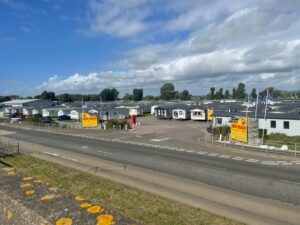 As Brighton has become very expensive London by the sea a wave of hipnification is sweeping over the old port town of Folkestone. The gentrification has not got far from town where static caravans make for inexpensive seaside holidays.
As Brighton has become very expensive London by the sea a wave of hipnification is sweeping over the old port town of Folkestone. The gentrification has not got far from town where static caravans make for inexpensive seaside holidays.
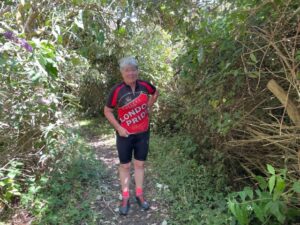 Meanwhile, in the lost world of Denge, Sid and Doris have left their bikes in the garden of a friendly native and set off through the undergrowth in search of sientificable things: Sound Mirrors.
Meanwhile, in the lost world of Denge, Sid and Doris have left their bikes in the garden of a friendly native and set off through the undergrowth in search of sientificable things: Sound Mirrors.
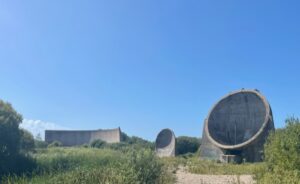 To know more, Andrew Grantham has a website devoted to this technology which Sid has gratefully plundered. These acoustic mirrors were a forerunner of radar, built on the south east and north east coasts between about 1916 and the 1930s.
To know more, Andrew Grantham has a website devoted to this technology which Sid has gratefully plundered. These acoustic mirrors were a forerunner of radar, built on the south east and north east coasts between about 1916 and the 1930s.
The ‘listening ears’ were intended to provide early warning of incoming enemy planes and airships. With the development of faster aircraft the sound mirrors became less useful, as a plane would be in sight by the time it had been located. Radar rendered the mirrors obsolete.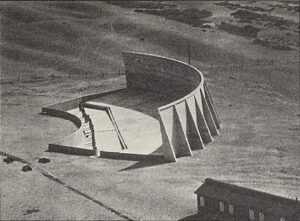
The nearest one is 20′ across and has a steerable sensor to give an idea of direction. The further one is a 200ft parabolic wall, seen in a period photo.
The structures have now been marooned on their own shingle island to stop vandals getting to them. They do have their own small fame. Sid and Doris found two other families had fought through the mallow and shingle to see hundred year old concrete.
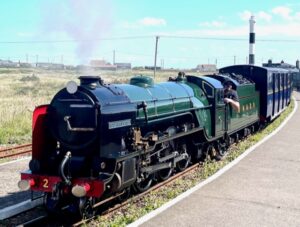 Much of the material for the acoustic mirrors was carried in to a specially laid siding by the Romney, Hythe and Dymchurch Railway. Everything joins up.
Much of the material for the acoustic mirrors was carried in to a specially laid siding by the Romney, Hythe and Dymchurch Railway. Everything joins up.
This super-sized train set was the dream of rich racing drivers Captain John (“Jack”) Howey and Count Louis Zborowski (of Benz aero-engined Chitty Chitty Bang Bang fame), though the ‘Count’ died at Monza in 1924 before the line opened in 1927.
The 15″ gauge 13 mile line runs along the coast from Hythe to Dungeness where a loop enables the return trip without shunting. Here is Northern Chief hauling a 14 carriage train with Dungeness lighthouse behind. Built in 1925 Northern Chief is still steaming along.
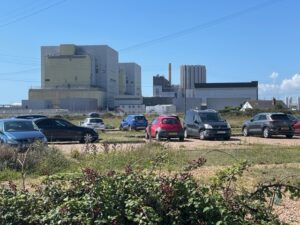 Dungeness A was a Magnox power station with two reactors and turbines which were connected to the Grid in 1965 and which successfully reached the end of its design life in 2006.
Dungeness A was a Magnox power station with two reactors and turbines which were connected to the Grid in 1965 and which successfully reached the end of its design life in 2006.
Dungeness B was an Advanced Gas Reactor power station with two reactors twice as powerful as the originals. They seem to have been very difficult to build and maintain. B was taken out of service after a short and troubled life.
In 2021 the estimated cost of decommissioning the UKs seven AGRs was about £24bn. The investment returns achieved by the Nuclear Liabilities Fund are nowhere near keeping up. Still, not many people think the answer is to re-open the Kent coalfields even if Northern Chief is a very pretty way of making steam.
Cycling away from Dungeness proves amazing hard work. We are now cycling towards Rye on terrible concrete slab surfaces, getting a bum bounce every twelve feet and the wind is … you know…
Passing Pontins Camber Sands Doris suddenly pulls off the road to get a picture of the holiday camp. ‘We stayed there.’ Doris may post on the remembered delights. Perhaps this is not its best side.
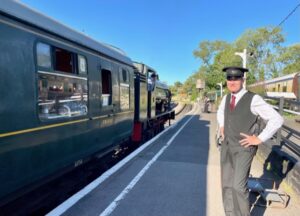 Doris has marked out a not so hilly route to Tenterden, a pleasant looking one street town with swish eating and down at the station a small brewery.
Doris has marked out a not so hilly route to Tenterden, a pleasant looking one street town with swish eating and down at the station a small brewery.
On the Kent and east Sussex Railway the last train of the day comes in, pulled by Sapper, a cheerful Hunslett Austerity built for the WD in 1944. This was the last steam locomotive in industrial service in the UK, being taken out of use from Bold Colliery in 1984. Is that a long time ago?
The Printing House is a very well appointed B&B pub, but the pub and dining element is shut tonight. Naturally the Turkish is open all hours providing the world’s best borek and beer. On this trip dinner has been quite good English, fab Indian in Canterbury at the Cook’s Tale, good Spanish tapas and now Turkish mezzes.
 Our morning ride into Ashford station takes us down Beaver Road where Sid’s maternal grandparents lived, working on the railway. Which will take us home.
Our morning ride into Ashford station takes us down Beaver Road where Sid’s maternal grandparents lived, working on the railway. Which will take us home.
We are unsure what sort of creature posed for this picture. It’s just good to see them recognised.
Epilogue: Sid has already fitted a sturdier rack to Doris’s Boardman and the experiment with electrically assisted touring will be tried again.
On this trip there has been more time spent getting off and looking at things rather than just making progress. That relies on there being things which sometimes there aren’t, as for instance in parts of Bulgaria.
Still, it is such a good way of travelling that Sid and Doris are looking for a diary slot to fit in EV5, the Via Romea Francigena, when there should be plenty of things to see and eat. As shown at en.eurovelo.com/ev5 the route goes down to Brindisi so no need to stop in Rome. Could you complete the pilgrimage in Jerusalem?
For tourism there are 21 UNESCO sites across seven countries and you could maybe ride home. That rack needs to be solid.

Ah, happy memories of the Romney Hythe and Dymchurch Railway from 1960s holidays! I didn’t understand till just now that it is a miniature railway … that explains the vagueness I used to feel about the size of trains, such a contrast between these trains in Kent and the massive Butler Henderson (and other trains) driven by my London Grandad ( https://preservedbritishsteamlocomotives.com/62660-butler-henderson-gcr-506-lner-5506-lner-2660-br-62600/ ). The RH&D railway was an annual treat, when when we took Gillingham Granny and Grandad for a holiday at St Mary’s Bay (aka St Mary in the Marsh). I remember my dad talking about the nuclear power station, also pointing out a series of lighthouses, each abandoned as the sea cast up more shingle (ref. Geography GCSE Shingle Foreland). But what I remember best were the strange gardens in front of every house, nothing but shingle.